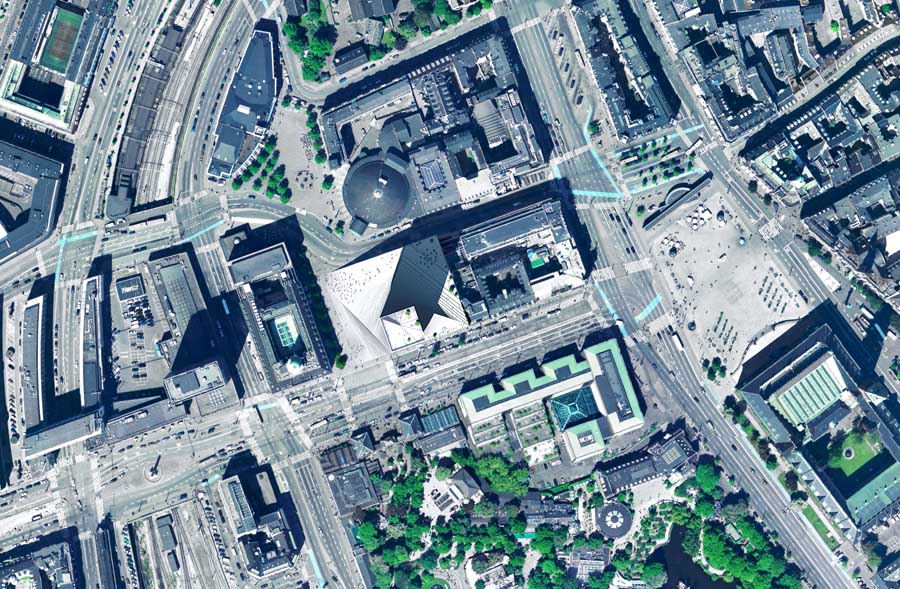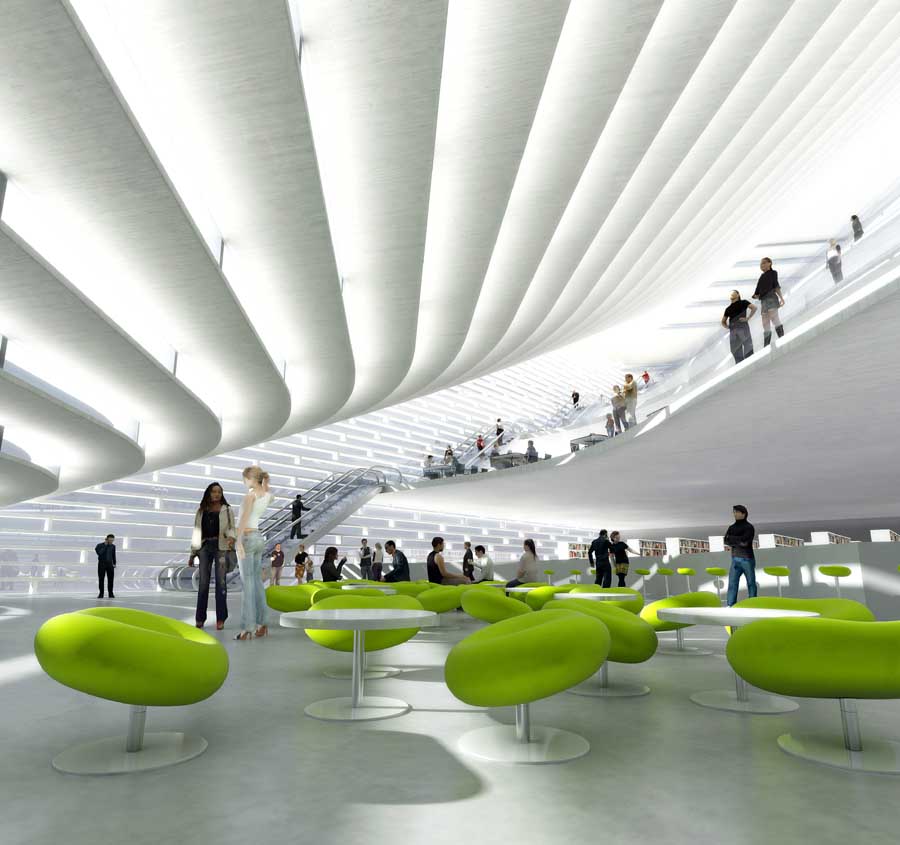
 The Danish architects BIG (the Bjarke Ingels Group) have designed an extraordinary hybrid tower Scala Tower to house the municipal library, conference centre, shopping and a luxury hotel. It also provides public space to the city of Copenhagen.
The Danish architects BIG (the Bjarke Ingels Group) have designed an extraordinary hybrid tower Scala Tower to house the municipal library, conference centre, shopping and a luxury hotel. It also provides public space to the city of Copenhagen.
Although it seems not quite fully resolved as to the programmatic and landscape elements, the way the building emerges from the ground ‘like a tree’ with a glassy bark trunk and yet sits well within the traditional urban fabric like a sinuous counterpoint is truly inspirational.
With a population of just over a million people and the famous Tivoli Garden, Kongen’s Have in the city centre and the Fredericksborg Slot Baroque gardens in Hillerod the Danes have the benefit of aesthetics, cultural and recreational opportunities aplenty.
So apart from contributing to Denmark’s already stellar reputation for being on the forefront of design how does Scala Tower contribute to the quality of life in Copenhagen? Political measures of quality of life in liveability terms are both objective [divorce rates, safety and infrastructure] and subjective [life satisfaction surveys]. So, the Danes have gained a great piece of civic infrastructure in a city which is already considered relatively crime free. I wonder whether that will show up on the next life satisfaction survey!

I love the tree form and hope the ground floor lobby is a semi-public realm, which I assume it is. But the site plan gives me the shivvers, as do photographs of the Antarctic. It has the geometrical perfection of ice and, as so often, seems to be conceived as a setting for architectural photographs. What a pity, it would appear, not to have paid attention to William H Whyte and Jan Gehl.
The problem can be stated as such interior design is not architecture is not landscape architecture is not urban design!
Although the site itself may lack resolution in terms of its landscape qualities (including the design of social spaces) from the site map it appears to address the volumetric qualities of the urban space and the relationship to other buildings around it well. (Without having a greater understanding of what these building uses are.)
For example as a general statement the site does not have an obvious front or back and the sides are also relatively equal in value. BIG do the architecture well as a set of built relationships. There are many specific things I cannot know without being on the scene so to speak to do a proper site analysis and spend time being immersed in the culture.
Copenhagen is a winter city, so street life is most likely strongly seasonal. All cities and cultures also have their own character…so Italy is vibrant, chaotic, warm-blooded and cultured…while Copenhagen is tolerant, freespirited, reserved and warmhearted. Viva la difference!
I am a great believer in small countries. I like their distinctiveness and, as my grandfather used to say, small countries make small wars and big countries make big wars.
One could say that the space is intended to be sublime and recognize this as a worthy ambition. But Copenhagen is only a winter city during the winter! It is warmer than London in summer and the lakes in some parks are used for outdoor swimming. This happens a little in London but ‘freaks only’.
Yes Copenhagen takes full advantage of its summer season and top of the list of the events it holds is the annual Summer Festival. [ http://www.youtube.com/watch?v=6yr2TbeEpxs&feature=related ]
However Copenhagen is definitely a winter city [ http://www.venere.com/blog/copenhagen-winter/ ]
…it celebrates summer…and as this fashion blog illustrates [ http://www.copenhagenfashionfestival.com/32761/Blog ]after a long dark winter “craves the summer”! [ http://www.flickr.com/photos/16nine/sets/72157600330678917/show/ ]
That is a lovely video of the 2 girls playing violins (but a pity the photographer did not compensate his exposure by about 1.5 stops!). Maybe I could do without the piano on stage but I like the grey heads in the foreground. Photography is a very interesting and appealing activity.
Re Copenhagen, it is such a good thing that they make outdoor swimming lidos in the parks.
Re the windmills in the sea, there should not be so many of them and they should be further offshore.
Despite the good news about Denmark’s green credentials it seems that the state owned energy company is making few friends in Scotland by investing in coal fired energy….
[ http://www.guardian.co.uk/environment/cif-green/2009/sep/17/greenwash-dong-energy ]
So if the alternative is more windmills in the sea close to shore or a coal fired power station in Scotland is suppose the better alternative is the former.
Yes as well as having a great cycling culture the Danish also have a great bathing culture. Having improved the water quality of the canals in recent years Denmark is famous for the Round Christiansborg competition.[ http://www.svoem.dk/t2w_1412.asp ]
One only needs to think of Greece to have doubts about the proposition that small countries are better than large countries and Scotland is another case in point. It is in the process of separating itself from England and the results seem to be more Greek than Danish – ie a fondness for high public spending and a disregard for the environment. Nor can I think of any outstanding building projects which can be attributed to the Scottish Parliament. Even the Parliament building itself is more of a cautionary tale than an inspiration to the future.
I am not sure what you are referring to when you say Scotland “has a fondness for high public spending and a disregard for the environment.”?
To be fair, in environmental terms the Scottish Parliament is advancing in small steps towards a more sustainable energy future.[ http://www.journalonline.co.uk/News/1007553.aspx ]So it is probably a case of two steps forward and one step back…
It is estimated that Scotland has 70% of the UK’s tidal power, so if this potential is developed well, Scotland will be well placed to power the more population intensive areas in the UK and to enjoy the economic benefits of this geographic good fortune. [ http://www.all-energy.co.uk/userfiles/file/Jamie_Hume_200509.pdf ]
And in social terms on the 2nd of October the Scottish Parliament famously convened an older person’s assembly. A participant says of the event;
“For me it was a great pleasure both to be able to speak about the work PRIME could deliver to help the Scottish Government create a wealthier and fairer Scotland, and to actually enjoy being in the ten-year-old Scottish Parliament building.”